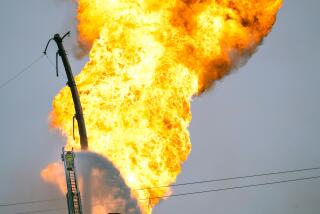City OKs First Stage in Replacing Oil Pipeline : Mobil: The ruling covers 26 miles of an aging 92-mile conduit from Lebec to Torrance. Traffic nightmares are anticipated.
The Los Angeles Transportation Commission Thursday gave Mobil Oil permission to replace 26 miles of its aging and leaky pipeline under busy city streets, and other jurisdictions along the 92-mile route from Lebec to Torrance are expected to quickly follow suit.
Despite the prospect of significant inconvenience to motorists and residents during its construction, the board unanimously approved the project because studies have shown that the existing pipeline is deteriorating and will rupture again if not replaced.
For the record:
12:00 a.m. April 13, 1991 For the Record
Los Angeles Times Saturday April 13, 1991 Home Edition Metro Part B Page 2 Column 1 Metro Desk 2 inches; 52 words Type of Material: Correction
Pipeline map--A map accompanying a story on the Mobil oil pipeline omitted part of its route through the San Fernando Valley. The pipeline, approved Thursday by the Los Angeles Transportation Commission, will follow Balboa Boulevard south to Rinaldi Street, travel east on Rinaldi, south on Woodley Avenue to Victory Boulevard, east on Victory to Sepulveda Boulevard.
The $90-million project could create bumper-to-bumper traffic along many of the major thoroughfares in its path, including Balboa Boulevard, Woodley Avenue, Sepulveda Boulevard and Inglewood Avenue, according to the environmental impact report.
The board also addressed public concern about increased air pollution from Mobil’s Torrance refinery by restricting the company to using only about 75% of the new pipeline’s capacity, or 95,000 barrels of oil a day.
Mobil officials said Thursday they never planned to use more than 75% of the new line’s capacity, but the board “wanted to make sure they lived by their word,” said Commissioner David A. Leveton.
Although the new line will carry about one-third more oil than the existing one, Mobil has said it will not expand its refining operations. Instead, it will cut down on the amount of oil it receives from other means, such as other pipelines and ships.
The existing line--a series of segments ranging in age from 2 to 50 years old--has ruptured eight times in the last five years, several times covering city streets with gooey crude oil. The most recent break, which occurred Feb. 1 in Santa Clarita, spilled more than 63,000 gallons of heated crude oil into the Santa Clara River.
“The current pipeline is dangerous to the point of certain rupture,” Commissioner Marion C. Fay said Thursday before casting her vote in favor of the project.
The commission’s decision was delayed for more than 18 months after public opposition prompted Los Angeles officials to back off from an earlier recommendation in 1989 to exempt the company’s plans from an environmental review.
The board was scheduled to decide on the project in February after certifying the environmental report. But that vote was postponed after commissioners heard competing pleas from San Fernando Valley politicians to reroute the line through the northern Valley.
The route chosen by the board Thursday was recommended by city transportation commissioners over the objections of Councilman Hal Bernson and state Assemblyman Richard Katz (D-Sylmar). The commissioners said the selected route, which follows Balboa Boulevard and Woodley Avenue, is preferable to the San Fernando Road-Sepulveda Boulevard alternate preferred by Katz and Bernson because it will avoid several earthquake faults and a storm channel to the ocean.
“It wasn’t a political decision against Bernson,” who Tuesday was forced into a runoff election, said Commissioner Nathan Chroman. “There will be less earthquake danger this way, and even though there will be traffic disruption with either route, it’s a transitory pain.”
To reduce the disruption, roadwork for the 18-month project will not be performed during rush hours, and in certain commercial zones all work will be done at night. Mobil also is considering tunneling under some intersections to reduce the need for lane closures and would provide temporary parking lots and shuttle service for Hawthorne and Lawndale residents who will have restricted access to their neighborhoods during construction.
Other jurisdictions along the 92-mile route, including the U.S. Forest Service and the cities of Hawthorne and Torrance, are expected to follow the lead of the city of Los Angeles and approve the project.
The U.S. Forest Service is likely to approve a 30-mile section of the pipeline through Angeles National Forest by the end of May, said Charlie McDonald, environmental coordinator for the agency. There is a 45-day appeal period before construction could begin, McDonald said.
In Hawthorne, city officials will approve the project if Mobil installs the new pipeline under 120th Street, which is wider than the proposed route under 142nd Street, said Michael Goodson, the city’s director of planning. Mobil officials said the city’s preferred route would be acceptable.
Torrance officials have yet to negotiate a franchise agreement that would allow Mobil to operate the pipeline in the city, but “we don’t see any major opposition on the horizon,” said City Engineer Richard Burtt.
Mobil will pay Los Angeles about $352,000 annually to operate the line, about $182,000 more than it pays for the right to operate the existing line, said Ken Cude, a Los Angeles transportation engineer.
Mobil Oil Pipeline Approved 26-mile segment through L.A.
More to Read
Sign up for Essential California
The most important California stories and recommendations in your inbox every morning.
You may occasionally receive promotional content from the Los Angeles Times.









